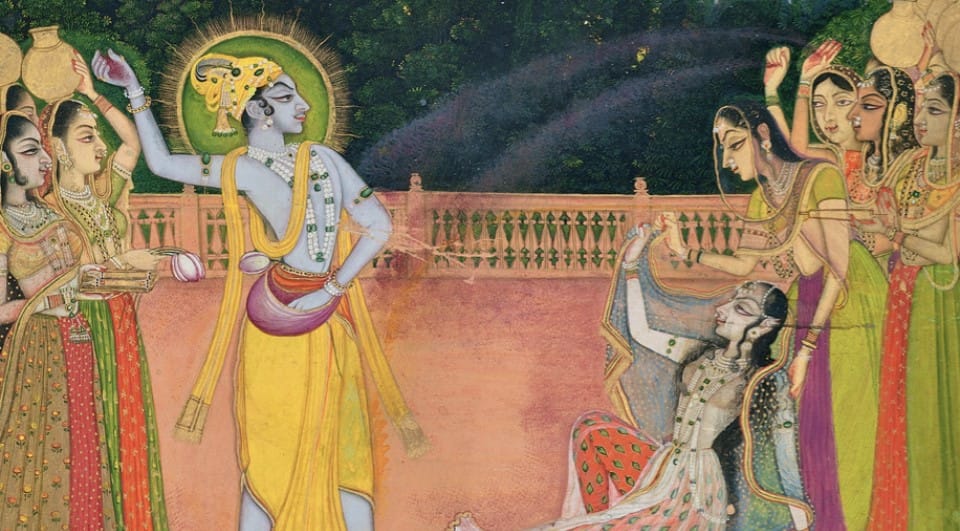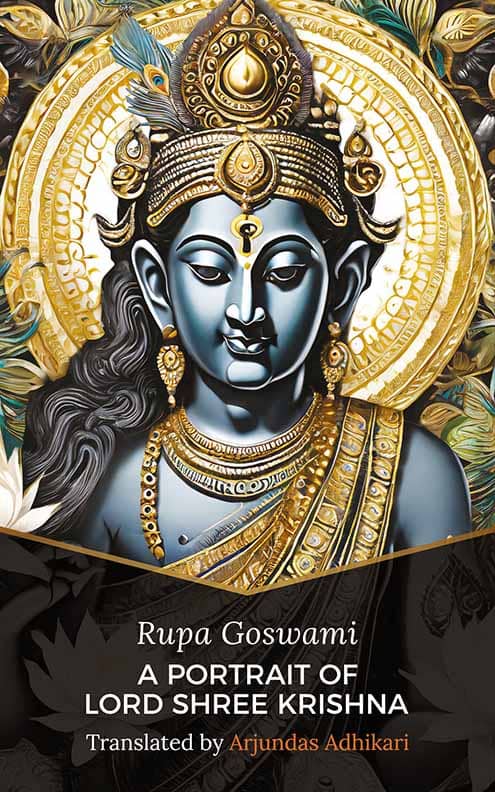
Vidagdha Madhava by Rupa Goswami is a play that falls within the very ancient tradition of Hindu drama, and more specifically, within the genre of Hindu drama that surrounds the glorious legend of Lord Shree Krishna and His beloved consort, Radha. Legends about Him are told in the very oldest of Indian writings, such as the Bhagavat Purana, the Brahmavaivarta Purana and the world-renowned Mahabharata.
‘Abhinaya’ is the Sanskrit word for acting, inherited from ‘abhi-ni’ which means ‘to bring close.’ Re-enacting the legends of Krishna puts us in touch with Krishna with an immediacy unlike any other. It’s why any dramas like A Portrait of Lord Shree Krishna by Rupa Goswami would have been admired so much by the sage Jaimini:
“It’s not easy to have Lord Shree Krishna appear by meditation, penance or any other means, but by means of dance-drama it is possible. It must surely be the best way to please Shree Krishna.”
Such entertainments are always prefaced with great ceremony, generally with opening prayers made to the god Ganesha to remove any hindrances to serious performances. The recounting of Krishna’s escapades was seen as so profoundly spiritual that many of India’s great Kings of the first millennium (those who founded India’s greatest Krishna temples) would inevitably sponsor dedicated, highly trained female dancers called devadasis to enact them every day upon a stage before the temple deities.
Often as dance-dramas, or in operatic style, the Krishna narratives have flourished in India for thousands of years, on open-air stages, in temples, and frequently in the very spots where they were said to have taken place. The playwright Bhasa of the 4th century BCE wrote many plays featuring Shree Krishna which are still current, and Krishna-culture was so famous in the 3rd century BCE that the Greek king Agothacles struck a coin that featured Krishna and His majestic disc; even Nawab Wajid Ali Shah* was inspired to write a drama about Radha and Krishna called Radha Kanhaiya Ka Kissa, and to choreograph kathak dances in Krishna’s honour.
Importantly, Krishna, the cowherd of the idyll, so commonly depicted in these plays, and so universally loved, has a metaphysical nature that makes Him eminently worship-worthy. Being the source of salvation, being beyond mortal existence, and having existed prior to creation, makes for an enduring popularity. Shree Krishna is the all-powerful Lord, but the most personable of beings too. Hence the longevity of His allure.
Krishna’s most confidential pastimes were, and are, enacted by performers called ‘rahasya-dharins, or, ‘secret-keepers’. Captain Thomas Broughton of the East India Company gives us an idea of their expertise in writing about his experience of their acting at the Sidhia camp in 1809:
Both the dancing and the singing of the rahasya-dharins was superior to that of common performers, their attitudes were exceedingly graceful and their voices were never raised above the natural pitch. The dresses were appropriate and elegant, specially that of Kanhaiya (Krishna) who wore a brilliant sun upon his head and a quantity of superb jewels around His neck and breast…
Letters From a Maratha Camp during the Year 1809
Arjundas Adhikari
*1822-1887

